How to grow garlic with the largest heads? First of all, you need to choose one of the largest varieties of this vegetable and decide on the planting method. It should be taken into account that summer varieties of garlic have an advantage in long-term storage, but are significantly inferior to winter varieties in the weight and volume of the fruit.
With some effort, you can grow garlic. large sizes
For large-sized heads, it is better to opt for the following varieties of winter selection:
- Gribovsky Jubilee - distinguished by purple husk, large head dimensions - up to 45 g. The variety is winter and frost-resistant. Sharp and shooting.
- Gribovsky 60 – winter, rather pungent variety, with covers lilac color and large heads. As a rule, the heads have 7-11 teeth. The variety is bolting.
- Danilovsky local also has purple scales. Large heads, up to 10 cloves. The variety is also winter, but non-shooting.
- Poretsky local is a non-shooting winter cold-resistant variety with pink-violet scales. Its large heads have 10-12 cloves. Spicy.
Winter varieties are planted before winter. Let's take a closer look at how to properly grow winter garlic with large heads.
Preparatory work before planting
One of the conditions for garlic to give large heads, – correctly combine the soil in the garden bed. This vegetable prefers loamy-sandy soils of neutral composition.
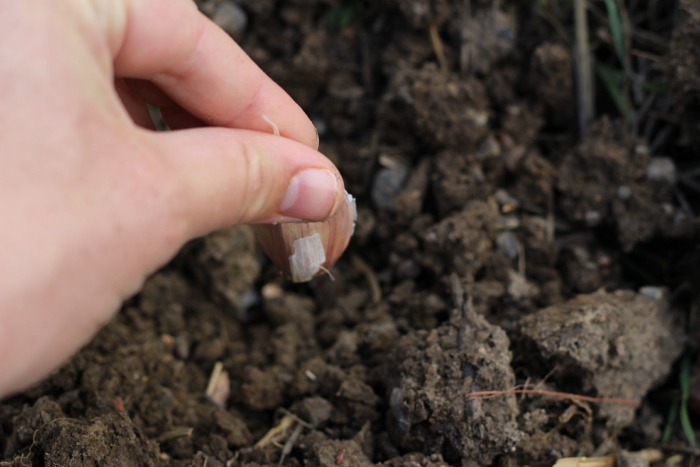
To get a good garlic harvest, you need to properly prepare the soil.
In order for garlic to produce large heads and grow healthy, its predecessors must be the following crops:
- legumes,
- pumpkin,
- cabbage
For the same purposes, it is not recommended to plant garlic in soil where tomatoes, potatoes, onions and garlic grew. This promotes infection by nematodes and fusarium, and will also cause the new harvest garlic heads to not be large enough.
The beds are prepared a month and a half before planting winter garlic, namely in August. You should choose a sunny place to ensure that this vegetable develops large heads in winter thanks to a sufficient amount of sunlight.
- 1 bucket of compost or manure,
- 1 tbsp. l. superphosphate,
- 1 tbsp. l. potassium sulfate,
- 1 cup fluff lime, chalk or dolomite flour.
Fertilizers are applied to the soil to a depth of 20 cm.
Loamy soil should be mixed with coarse river sand or peat so that the garlic heads have the opportunity to be saturated with oxygen, which will allow them to grow large enough. Proportion: 1 bucket per 1 m2.
Peat soils, on the contrary, are mixed with a bucket of loamy soil and sand for each square meter, and sandy ones - 2 buckets of peat and loamy soil per square meter. All types of soil should be fertilized with all the substances listed above.
After applying fertilizers, the beds are dug up and compacted. And at the very end, copper sulfate is also added in the proportion of 1 tbsp/10 l of water. For every square meter of soil, 1 liter of solution should be used to grow a crop with large heads. After tilling the soil, the beds are covered with polyethylene and left until our vegetables are planted.
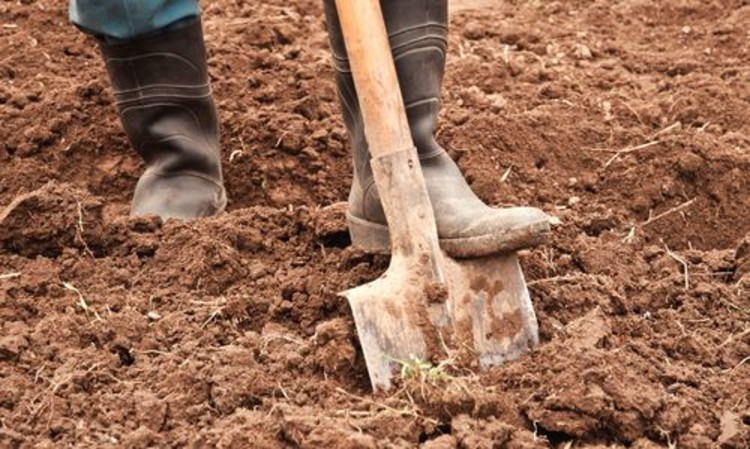
Cultivating land for garlic crops guarantees a rich harvest
Planting dates for winter garlic
How to grow a large, healthy winter garlic on one's own? It should be planted 40 days before heavy frost. During this period, the cloves planted in the ground should have time to take root to a depth of at least 10 cm, but under no circumstances should they sprout green leaves. Without observing planting dates, it will not be possible to grow large enough garlic.
The optimal time frame is the period from the beginning last decade September until the end of the first ten days of October. If you plant garlic earlier, it will sprout greens, which will lead to partial frostbite and death of the vegetable, and if later, it will not have time to take root before frost and will not produce a harvest, especially large heads.
Selection of seed material
It is possible to grow garlic with large heads only from seed from the harvest that was harvested in the summer of the same year. The heads should be divided into cloves, avoiding damage to the peel. You should take only large and healthy teeth.
Immediately before planting, the teeth should be kept for at least 2 minutes. saline solution. It is prepared as follows: 3 tbsp. l. table salt for 5 liters of water.
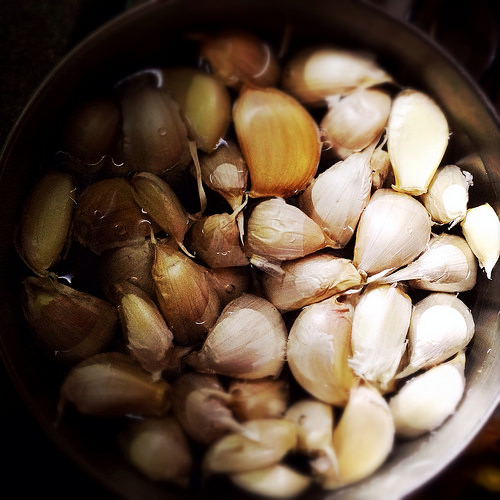
Soak the garlic in a special solution - this will protect the future harvest from diseases
After this, you need to prepare a solution of copper sulfate. To do this, stir 1 tsp in 10 liters of water. substances. Seed garlic cloves are kept in the solution for 1 minute. These simple steps will protect the crop from pests and diseases, and will also allow you to grow fairly large garlic heads.
After these procedures, the vegetable can be planted.
Technology for planting winter garlic
When figuring out how to grow large garlic in your garden, you need to learn how to properly plant the beds. They are made at a distance of 20-25 cm from each other by forming grooves up to 10 cm deep. The teeth prepared for planting are immersed in these grooves. How to position your teeth correctly? As follows: at a distance of 5-6 cm from each other, strictly vertically, that is, with the bottom down, and the ovary of the future greenery up, we deepen the teeth 3-5 cm from the surface of the soil.
The cloves are immersed in moist soil, that is, the bed must first be watered.
At the first cold snap, the beds with winter garlic are insulated. To do this, you need to sprinkle them with peat in a layer of 5-10 cm so that the garlic does not freeze and grows large.
Techniques for caring for winter plantings
In the spring, at the first warming, the peat layer is removed and the soil is loosened between the rows to a depth of 5 cm. This will give the grown vegetable access to the required amount of oxygen, which will allow you to get a good harvest. By this time, the first green shoots usually appear.
It is recommended to water garlic beds throughout the spring and two months of summer. The average amount of water required for this is 10-12 l/m2. The procedure should not be repeated more than once every 5-8 days. In July, watering should be suspended to avoid rotting. The crop ripens in dry soil for at least 20 days before harvesting.
A caveat should be made that the beds need to be watered as needed during dry periods in the summer. Garlic is not picky, does not require much moisture and, with sufficient rainfall, can do without irrigation.
Top dressing
To grow garlic that has really large heads, you need to feed it with urea. To do this, dilute 1 tsp. the drug in 10 liters of water and sprinkle the garlic using the sprinkling method. Spraying rates: 2-3 liters per square meter of beds. The first procedure is in March.
The second feeding is done using nitroammophoska. Prepare in the following proportion: 2 tbsp. l./10 l of water. You need to spend up to 4 liters per square meter. The solution is also sprayed onto the beds.
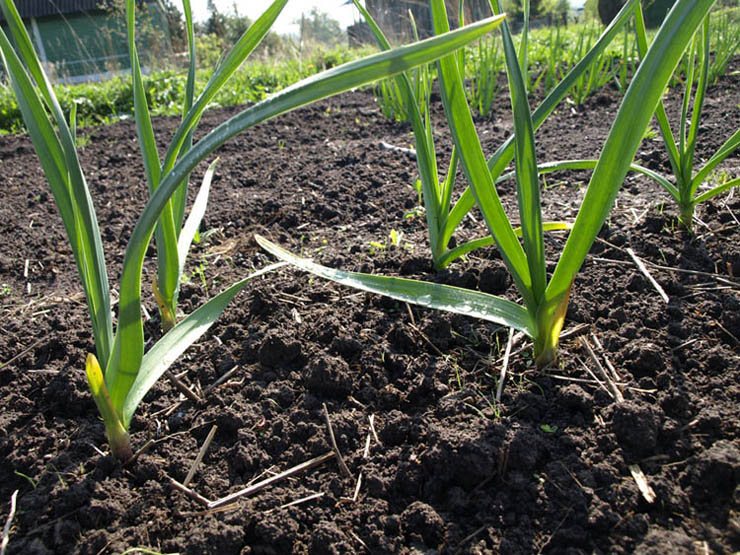
Timely feeding of garlic will benefit it
The last fertilizing is done with crushed superphosphate by watering the beds. The solution is prepared in the proportion of 2 tbsp. l. fertilizing for every 10 liters of water. Consumption: 2-3 liters per m2. It is recommended to carry out the procedure in the second ten days of May, during the intensive growth of garlic heads.
How to grow garlic with large heads from seeds
Now let's look at how to grow seed garlic, how to plant it and when to collect seeds for planting.
Garlic seeds grow in inflorescences on the top of the arrows of winter varieties. You need to know the timing of their collection in order to prevent over-ripening or harvesting under-ripe.
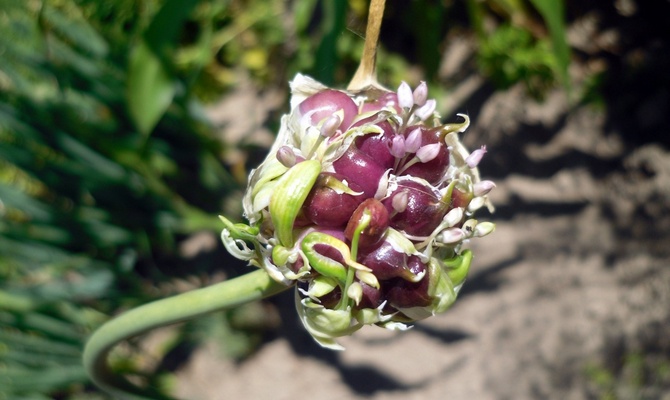
The method of planting garlic by seeds has its advantages.
Rules for collecting and storing seeds
The optimal indicator for collecting seeds is the film on the inflorescences that has begun to crack. Collecting seeds in this period is optimal, since the film, which does not have time to burst completely, protects the seeds from scattering both during their collection and during storage. The seeds are stored suspended in ventilated rooms in the form of peculiar sheaves: the inflorescences are cut off along with parts of the arrows and tied in bunches. With this storage method, seeds can remain viable for up to 5 years.
Landing technology
How to grow large seeded garlic? The sowing technology is tape, that is, two rows are planted at a distance of 10-15 cm, then an indent of 35-45 cm is made, then 2 more rows with a distance of 10-15 cm from each other. To grow large garlic, the distance between the seeds in a row should be maintained from 3 to 5 cm, and should be deepened by 3-4 cm.
Garlic is a universal agricultural crop. It is grown in various climatic zones and added to food as a kind of spice and flavor enhancer for meat dishes. Most domestic gardeners also cultivate this vegetable. It would seem that there is nothing complicated in this process. But is it possible to make sure that the harvest surprises not only you, but also your neighbors? To do this, you will have to master several agricultural secrets. Only in this case will you definitely understand the question of how to grow large garlic in the garden.
While experienced gardeners probably know the difference between them, novice farmers may be a little confused. Spring garlic is planted in the spring, while winter garlic is planted in the fall. Try not to make mistakes in the optimal planting periods, otherwise you may not get a harvest. What is the characteristic of winter? It consists of several small but aligned teeth and a central shaft. The spring variety does not differ in the presence of a special trunk. In addition, its teeth mostly vary in size.
If we consider varieties from the point of view of harvest storage, then it is better to pay attention to spring garlic. Its fruits are stored for quite a long time in utility rooms, cellars or attics. They are consumed during winter and spring, and if all conditions are provided for bunches of homemade garlic, it will retain its taste and nutritional properties until next spring. This does not apply to winter varieties of vegetables: they are best consumed in fresh after harvest. You can also store the harvest, but the result is not always satisfactory.
However, the winter plant has its advantages. Experts believe that farmers harvest a much more generous harvest after planting winter garlic, rather than spring garlic. In general, there are enough problems with growing this agricultural crop. She has trouble adapting to different climatic conditions. So that your efforts are not in vain, Special attention pay attention to the selection of seed material.
First of all, buy quality varieties. IN this moment modern breeders are working to improve key properties agricultural crops: keeping quality, productivity, frost resistance, as well as early maturity. It is better to choose those varieties that include these characteristics, developed at a high level.
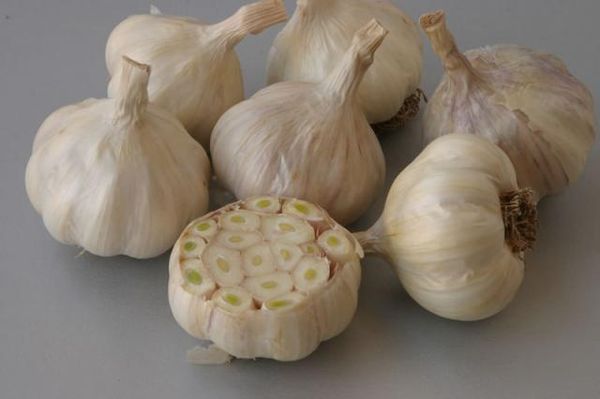
Fertilizing the beds
Every gardener needs to know how to grow homemade large garlic correctly. First of all, it is recommended to select the optimal plot of land. If you plant the tines in an unfavorable location, all your subsequent attempts to improve yields will fail. Where should garlic grow? Choose an unshaded, well-lit area in your garden.
It is very important that groundwater is not located too close to the surface in the soil. Excessive amounts of moisture can be the main cause of fungal diseases in garlic seedlings. However, if for your area high level groundwater occurrence is characteristic feature, you can go the other way: provide a high bed in the garden. Thus, the root system of homemade garlic will not reach the water and will be able to to the fullest develop.
The key point after choosing quality varieties for planting is the process of soil preparation. If you plan to sow winter garlic, you need to start cultivating the soil at least two weeks in advance.
In the case when planting a vegetable is planned for the spring, it is still recommended to add fertilizer to the soil in the fall. The garden needs to be dug up and then compost or humus added.
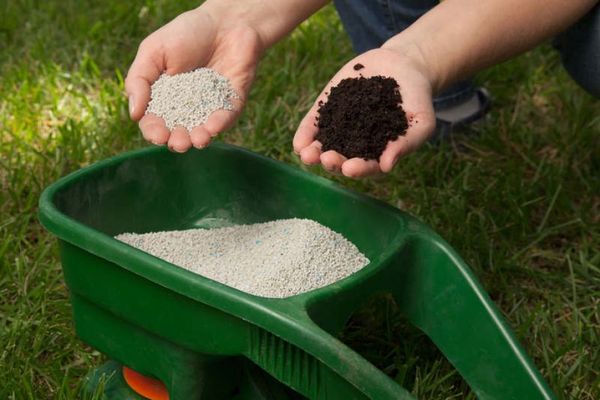
If the soil itself is well fertilized, there should be plenty of these fertilizers. However, to enhance the effect, you can add sand, turf soil, and peat to the soil. The soil must contain organic fertilizers large quantities. Only in this case will it be sufficiently loose and enriched with nutritional components.
Preparing cloves for planting
During the growing process plot of land When growing homemade garlic, you need to pay attention not only to the preparation of the soil itself, but also the seed material - garlic cloves. First of all, farmers select the largest and healthiest-looking cloves from the previous harvest. There should be no damage or stains on them. After selecting specimens suitable for planting, it is imperative to disinfect them with a 1% solution of copper sulfate. This procedure is quite simple to implement: the grains are placed in the mixture for literally a minute. This treatment is carried out to eliminate fungus and other pathogenic bacteria. But this concerns winter garlic.
Specimens that farmers prefer to plant in open ground in the spring, it is also recommended to prepare. To do this, they are placed in the refrigerator for two to three weeks. The cooling process of the tines prevents them from sprouting prematurely. After this procedure, the seeds must be wrapped in a damp cloth. During this period, they are already actively germinating, and when the soil in the garden warms up, they can be planted in open ground.
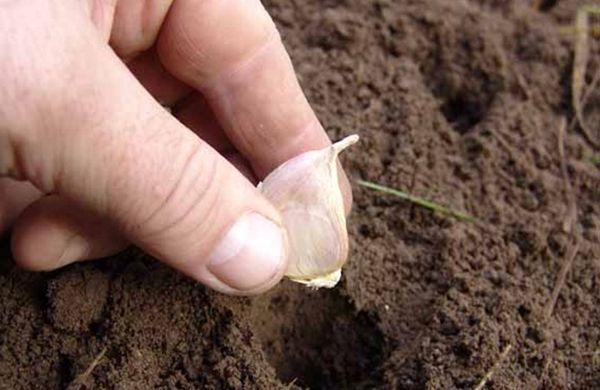
in spring
The optimal time for planting spring garlic is mid-April. At this point, the soil temperature reaches about +7 degrees, so you can safely carry out gardening work. If there is moisture in the soil at the time of planting, there is no need to water it additionally. Gently distribute the garlic in the beds. It is very important here not to damage the root system of the crop. After you have planted garlic, it is recommended to mulch the beds.
Don't wait long for spring warmth. Even if frosts begin after planting the vegetable in the ground, this will not affect the seedlings of the crop. The main thing is to ensure proper care of the plants in the future.
in autumn
We grow homemade large garlic on modern stage everywhere. The process of planting grains itself is not too labor-intensive, no matter whether we are talking about winter or spring garlic. However, you should not start gardening procedures if you certainly do not know what features distinguish planting winter garlic in the garden. Meanwhile, their own technology is being practiced here. First of all, the teeth should be heated to a temperature of +40 degrees, and also treated with saline solution.
Do not forget about preparing the soil: it is necessary to apply fertilizers (potassium chloride and superphosphate). Immediately after planting the tines, it is worth loosening the soil. For greater effect, you also need to mulch the soil with a layer of peat or humus.
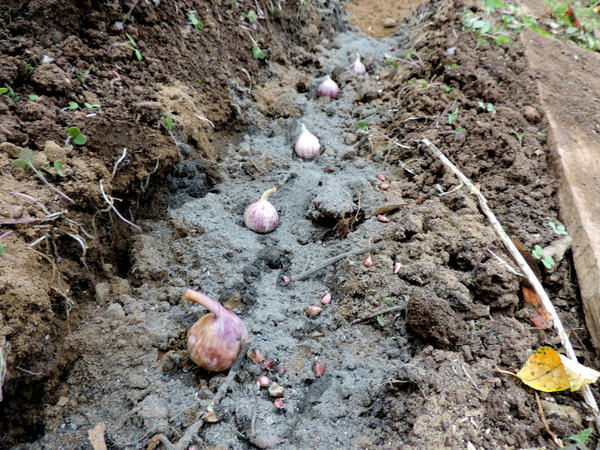
What makes the process of growing winter garlic a little more difficult is the winter cold. You will be very lucky if the winter turns out to be snowy, and the cloves of winter garlic will be covered not only with a layer of soil, but also with a decent ball of snow. But what if the frosts are getting stronger, but there is still no snow? You need to take care of the vegetable yourself. Some gardeners prefer to cover garlic with film.
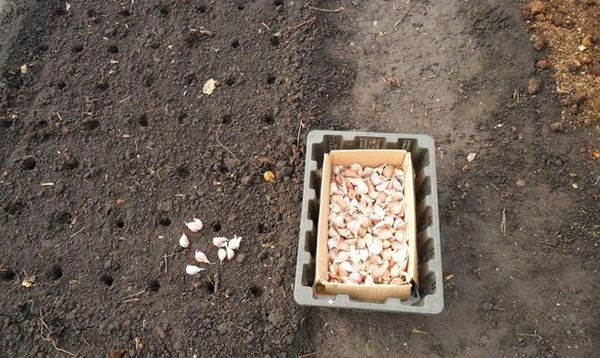
However, there is a plant alternative: nut leaves. Why should they be used? The thing is that they will not only be able to protect the garlic from severe frosts, but will also prevent the process of yellowing. Another significant point in the process of planting winter garlic is that you do not rush to carry out garden work. If you plant it too early, the plant will already germinate by the time cold weather sets in, which means it will simply freeze in the winter.
Secrets of large garlic
Every gardener wants the garlic he planted to not only grow ugly, but to grow to a fairly large size. Agree, large garlic is more pleasant to peel later, but this vegetable is used very often in the kitchen. Several points will help influence the yield:
- time to plant garlic cloves;
- choosing the optimal varieties for cultivation in your area;
- replenishing the soil with nutritional components;
- regular updating of planting material;
- stable watering;
- mulching the soil, etc.
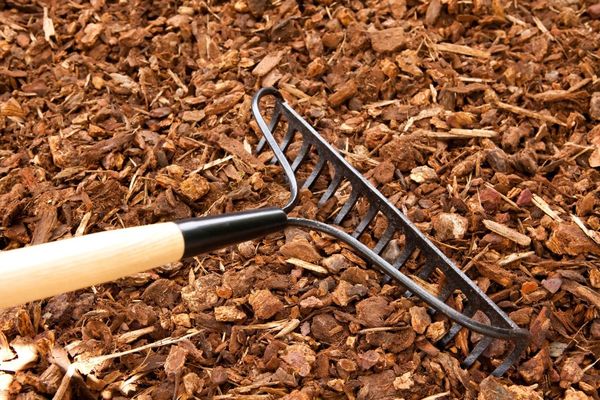
Not every gardener can ensure the timely implementation of all agrotechnical practices. However, not everyone has that much time, because, as a rule, in the garden and summer cottage Other vegetables, flowers, and berries are also cultivated. And everyone needs to be properly cared for. However, if you follow the principles of growing homemade garlic, you can reap a decent harvest.
Video “Secrets of a successful garlic harvest”
From this video you will learn how to grow a rich harvest of garlic.
Svetlana
For garlic, select an area with fertile soil that has a neutral reaction. The best predecessors are early cabbage, cucumbers, and zucchini, under which organic fertilizers were applied.
Garlic should not be placed after onions and garlic earlier than 4-5 years due to common pests and diseases. It is not recommended to grow after potatoes, as the plants are affected by fusarium.
In the autumn, after harvesting the previous crop, organic and mineral fertilizers are applied to the garlic (5-6 kg of humus or compost, 30 g of superphosphate and 20 g of potassium chloride per 1 m2). Then the area is carefully dug up using a full shovel, evenly mixing the fertilizer with the soil.
Growing winter garlic. Winter garlic is planted in the second half of September - early October in a garden bed in a row at a distance of 20-25 cm row from row. The cloves, depending on their size, are planted in a row at a distance of 5 to 8 cm from each other, the planting depth is 3-4 cm, counting from the top of the clove to the soil surface. Planted garlic is mulched with peat or humus in a layer of 1.5-2 cm (1.5-2 buckets per 1 m2).
In spring and summer, caring for garlic consists of fertilizing with nitrogen fertilizers, watering as the soil dries, weeding and loosening the soil between the rows. The arrows must be regularly removed at the beginning of their formation so that the bulbs are large. Leave them only on seed plants. Winter garlic ripens in late July - early August. You should not be late in harvesting garlic, as the heads will crumble when they become overripe. Therefore, when the leaves of garlic begin to turn yellow, the plants are pulled out of the soil and dried for 4-5 days - in sunny weather on a ridge, and in rainy weather under a canopy or in a well-ventilated dry room. After drying, cut off the roots and tops, leaving a “neck” of 4-5 cm long on the bulbs.
Growing spring garlic. Spring garlic is inferior in yield to winter garlic, but has the ability to be stored for a long time.
It is grown in areas with highly fertile soil that has a neutral reaction, with the application of organic and mineral fertilizers of the same composition and in the same doses as for winter garlic. Plant garlic in the spring after the soil has thawed, as early as possible (in April-May). The planting rate is 50-70 g per 1 m2, the distance between rows is 20-25 cm, in a row - 5-6 cm. The planting depth from the soil surface to the top of the clove is 2-3 cm.
The emerging seedlings are fed with urea (10-15 g per 1 m2) and watered as the soil dries.
During the period of bulb formation, 50 g of superphosphate and 15 g of potassium chloride per 1 m2 are added as top dressing.
Spring garlic is harvested when the lower leaves dry out, the upper leaves turn yellow and lodging at the end of August - the first half of September.
You need to prepare a bed for spring garlic about a month before sowing it. It is better to choose the place for the garden bed where carrots, tomatoes, peppers or cauliflower used to be.
For one square meter of land under garlic you need to add one bucket of rotted humus and sawdust(you can take them fresh), one at a time liter jar grass or wood ash, fluff lime and bird droppings.
After adding humus, the soil needs to be dug up and leveled. After the remaining components, simple harrowing is sufficient. After this, the bed must be watered heavily from a watering can and covered with old film or cardboard.
When growing garlic you should consider:
- raking the earth from the head of garlic in the second half of June contributes to the formation of a more even and larger head;
- if you tie garlic leaves in a knot two or three days before harvesting, this will speed up its ripening and improve its shelf life;
- to obtain a high yield of garlic, you need to fertilize it at least twice with mullein (1 kg per 8 liters of water) or chicken droppings (1 kg per 10 liters of water) per 5 square meters.
The first feeding should be done in the phase of plant germination, and the second - in the phase of formation of heads
To grow large garlic, you must first of all pay attention to the seed. Slices of well-ripened garlic should be easily separated from each other, the skin of the cloves is dense, often pinkish-brown, not milky white, and the bottom is dry. Never plant garlic damaged by mold and rot! He will ruin your entire harvest.
Before planting, soak the planting material for several hours in a fairly strong manganese solution (the color is almost purple, not pink). If there is a spore or two of some fungus stuck there, manganese will disinfect everything.
Plant garlic at a distance of at least 20-30 cm from each other, make the beds so that you can walk through them when the garlic grows, take only the largest specimens for planting. This is the key to your success.
When the garlic grows, it is about to bloom. Don't give him this opportunity! All arrows must be removed regularly. Otherwise there will be no harvest. You can leave one or two arrows for reproduction, but that is a completely different story.
It is necessary to harvest only when the above-ground part of the garlic begins to turn yellow. You dig it up entirely, shake it off the ground and place your crop in the shade, without cutting off the roots or stems. They should dry out. Periodically turn over and stir up the collected plants so that they dry evenly: the lower layers (this is when the harvest is large and you have to stack it in a thick layer) have the unpleasant property of getting warm. When all the tops have become almost dry, carefully cut them by 10-15 cm, and at the same time the dried ends of the roots. This will allow you to save your harvest without loss!
Is there a special secret to growing or is it enough to follow? certain rules, let's find out in this article...
Fertilized bed for a good harvest
It is advisable to place the garlic bed in a sunny place, without stagnant water and close groundwater flow. Excess moisture accumulating in the ground leads to poor growth, in most cases, fungal diseases. A high bed can correct the situation. If everything is in order with the water in the garden, pay attention to the previous crops grown on the ridge before the garlic.
All kinds of onions, garlic, potatoes, tomatoes, radishes, eggplants and beets are bad predecessors; agronomists consider green manure (mustard, clover, alfalfa, oats), zucchini, wild strawberries (strawberries), cucumbers, peas, pumpkin to be the best. Planting after root vegetables and nightshades increases the risk of diseases and leads to a reduction in the size of the garlic head.
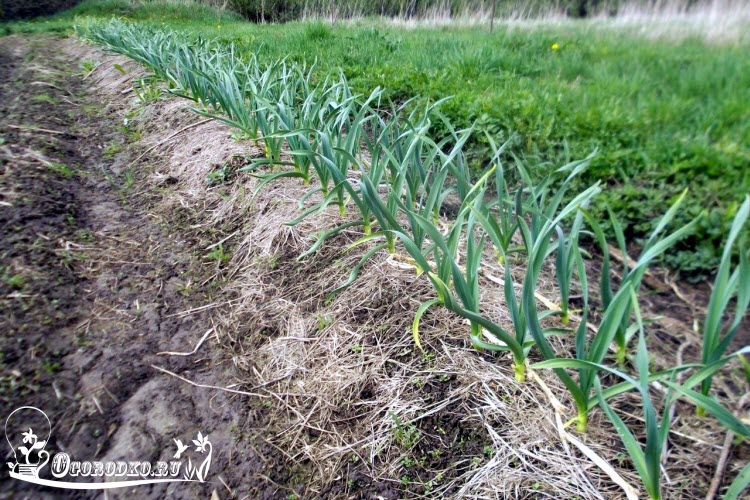 in the photo - the garlic bed was mulched for the winter
in the photo - the garlic bed was mulched for the winter
In the autumn months, the soil is prepared 10-14 days before the intended planting, the soil will settle and the cloves will not drown. Deep planting leads to smaller cloves and poor storage. It is recommended to prepare the bed for spring planting in the fall; the fertilizers will have time to transform into a digestible form for plants, supplying the garlic with nutrients in early spring already in the first days after disembarkation. Dig the soil to the depth of a spade, add compost or humus at the rate of 5-8 kg/m².
Depending on the soil, additional sand, turf soil, and peat are added to achieve water and breathability. Light, loose soil, seasoned with organic fertilizers, has a beneficial effect on the cultivation of large garlic. Inability to apply organic fertilizers in the required quantity, can be replaced mineral complexes fertilizers (30-40 g/m²).
How to prepare garlic for planting?
Growing large garlic is accompanied by the stage of preparing the cloves for planting in open ground, regardless of the time of year. Preventive actions, aimed at protecting the cloves from all kinds of pests and diseases during the growth process, improve the protective properties of the plant and increase the quality of the future harvest.
Select planting material, discard diseased, rotten, moldy cloves. You cannot peel garlic before planting; you just need to separate a couple of cloves and inspect for defects. If the head has a damaged tooth, do not use it for planting to avoid infection. It is recommended to divide the head of garlic into cloves immediately before planting it in the garden, and not a month in advance, as many novice vegetable growers do.
After examining for diseases, select the largest cloves, only from them you can get large, good garlic. It is worth noting that a small number of cloves (2-3) in the head, the presence of fused (double) ones, indicates the degeneration of the vegetable, such planting material cannot be used for cultivation, the harvest from such plantings will be small and of poor quality.
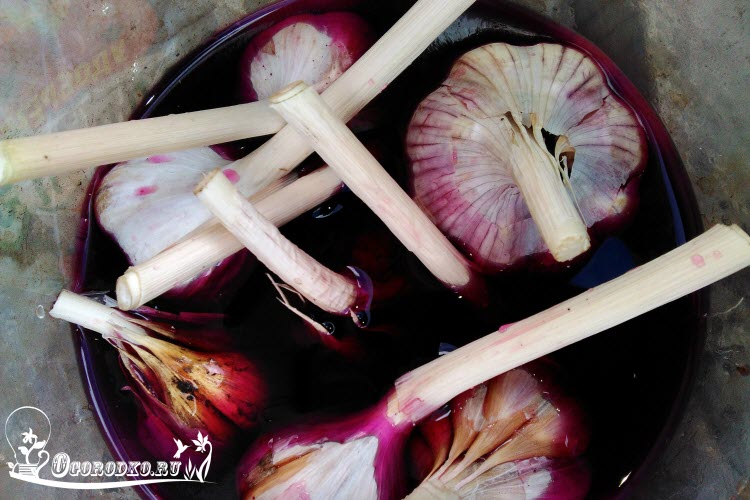 in the photo - soaking winter garlic in potassium permanganate before planting
in the photo - soaking winter garlic in potassium permanganate before planting
Garlic can be disinfected before planting different ways, one of them is soaking in an ash solution. To prepare, take 300 grams of wood ash, boil in two liters of water, cool, carefully separate the light part of the contents, immerse the cloves in it for one hour. Use potassium permanganate (1%), Fitosporin-M or copper sulfate solution (1%), immersing the garlic in the liquid for 20-30 minutes.
Preparing spring garlic for spring planting has special requirements. If storage conditions are not met (plus temperature 5-8 ºС and optimal humidity 30-50%), a month before the intended planting, the garlic is placed in the cold, where the air temperature will range from -3 to +2 ºС. At home, such a place can serve as a refrigerator. During the day, the planting material is removed, warmed to room temperature, dipped in a disinfecting solution, then immersed in a growth stimulator (Epin, Potassium Humate) for 12 hours. Such cooling promotes the growth of heads with a large mass.
Planting in spring and autumn
Planting garlic in early spring begins at a time that is different for all regions, but the months of April and May serve as a guide; the main criterion for proper planting is the soil temperature exceeding zero degrees. As soon as the snow has thawed and the sun has warmed up, it’s time to plant the cloves in moist soil without watering; it is recommended to water dry soil.
The distance between rows is 0.15-0.20 meters, between plants 9-10 centimeters, focusing on the subsequent convenience of processing garlic. It is advisable to increase the openings and spaces between plants when combining plantings. The depth of spring planting of cloves is small, 2-3 centimeters. Garlic beds can be mulched in the spring immediately after planting in the ground with peat, or with other materials after germination.
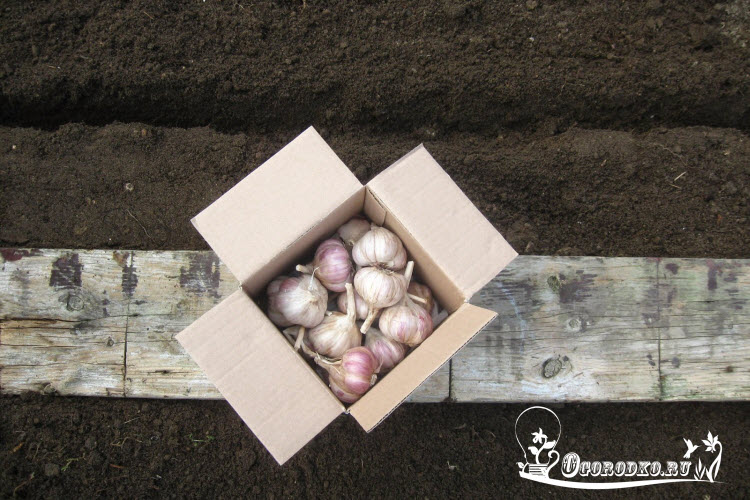 in the photo - planting garlic
in the photo - planting garlic
Autumn planting of garlic before winter is carried out in September or October, taking into account the regional affiliation of the cultivation zone. In the central and middle parts of Russia, the season begins with last week September and early October, in the southern regions and Kuban the dates shift closer to October 14-18. The cloves must take root before winter, but not germinate, then the garlic will calmly overwinter and bring a large harvest.
The autumn planting pattern is no different from the spring one, the only difference is in depth. You need to plant to a depth of 3-5 centimeters from the top of the clove to the surface of the soil; shallow planting increases the risk of freezing in the winter months, especially in winters with little snow and frost. Experienced gardeners recommend sprinkling sand or wood ash at the bottom of the furrows; adding significantly reduces the likelihood of the bottom rotting.
The soil in the beds is leveled, the plantings are mulched with peat and rotted sawdust. The use of straw as mulch is recommended in areas where there are no rodents, otherwise they will spend the winter there. The layer of mulching material should be at least 2-3 centimeters. Garlic planted in the fall is not watered. With the arrival of sharp frosts without snow, you need to cover the ridges with roofing felt or thick film, and remove them when snow precipitation appears.
Secrets of large garlic
According to gardeners, simple tricks allow you to grow a wonderful, healthy crop that will be perfectly stored. Let us dwell on the most significant points, the observance of which will invariably lead to garlic happiness:
- The rule of planting is that if you stick it into the ground on time, you will always have a harvest;
- Right choice varieties - necessary important point, low-yielding varieties with poor disease resistance will never produce large heads, always remember this;
- Renewal of planting material. After three years, garlic begins to shrink and degenerate; it is necessary to carry out health improvement by growing the vegetable through bulbs;
- (no more than 3 times during the growing season), organic matter is considered the best fertilizer, but in moderation. Excess nutrients leads to yellowing of foliage and diseases;
- Breaking out the arrows of bolting varieties speeds up the process of ripening the head and also makes it larger;
- Tying the leaves is carried out to stimulate the outflow of nutrients from the leaves into the bulb. The method is rarely used for winter plantings, but spring garlic is tied to speed up the ripening and weight gain of the head, the garlic will grow larger;
- Water generously initial stages growth, in the second half of the growing season, irrigation is reduced to a minimum;
- The use of mulch has a beneficial effect on the growth of the garlic head and garlic in general, especially on hot days (temperatures above +25 ºС inhibit the development of the vegetable). Mulch will save the root system from overheating and retains moisture for a longer period.
I suggest watching a VIDEO about interesting ideas for planting garlic:
Garlic is a vegetable crop that is often and happily used in our kitchen. Many owners of dachas and plots grow it themselves, preferring winter crops. Indeed, this vegetable is unpretentious and does not require incredible labor costs. The only thing that gardeners often worry about is how to grow large winter garlic.
The first secret is timely landing
In order for winter garlic to grow large, you should try to plant it approximately 25-35 days before the onset of constant cold weather. Then the cloves will have time to take root in the soil, but will not sprout greenery. This means that the vegetable will not only not waste nutrients on seedlings, but will also overwinter well.
The second secret is good soil and fertilizers
Garlic responds well to fertile and loose soils with a neutral reaction. The best predecessors for vegetables are zucchini, squash, grains and green manure herbs (alfalfa, clover).
Poor soils are best fertilized. In the list of what you can feed garlic to make the heads large, organic matter (humus) undoubtedly occupies a special place. You can also use mineral fertilizer if you prefer complex preparations, pay attention to the “AVA” product.
Garlic responds well to this solution, which is prepared from three ingredients:
- 1 cup bird droppings;
- 10 liters of water;
- 1 tablespoon of urea.
All components are mixed, and the resulting solution is watered over the beds.
Secret three - remove the arrows
Unlike spring garlic, winter garlic produces shoots on which seeds usually develop. However, here lies the most main secret large garlic. The fact is that these arrows actually need to be removed unless you intend to collect seed material for planting next year.
The arrows draw some of the nutrients onto themselves, which is why a considerable part of the energy 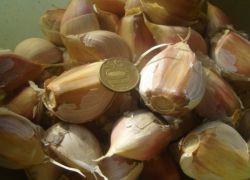 will go not to the development of the underground part, but to the formation and maturation of seeds. It is logical that in the end the head of garlic will not grow large. Remove the arrows as soon as they curl. By the way, experienced gardeners still recommend leaving one arrow on the plot in order to monitor when the garlic is fully ripe. This can be seen immediately - the poured arrow straightens.
will go not to the development of the underground part, but to the formation and maturation of seeds. It is logical that in the end the head of garlic will not grow large. Remove the arrows as soon as they curl. By the way, experienced gardeners still recommend leaving one arrow on the plot in order to monitor when the garlic is fully ripe. This can be seen immediately - the poured arrow straightens.
The fourth secret is watering
Typically, the condition for growing garlic in large heads is timely watering, especially during the dry period. True, an excess of moisture is detrimental to agriculture, so it is important not to overdo it.


